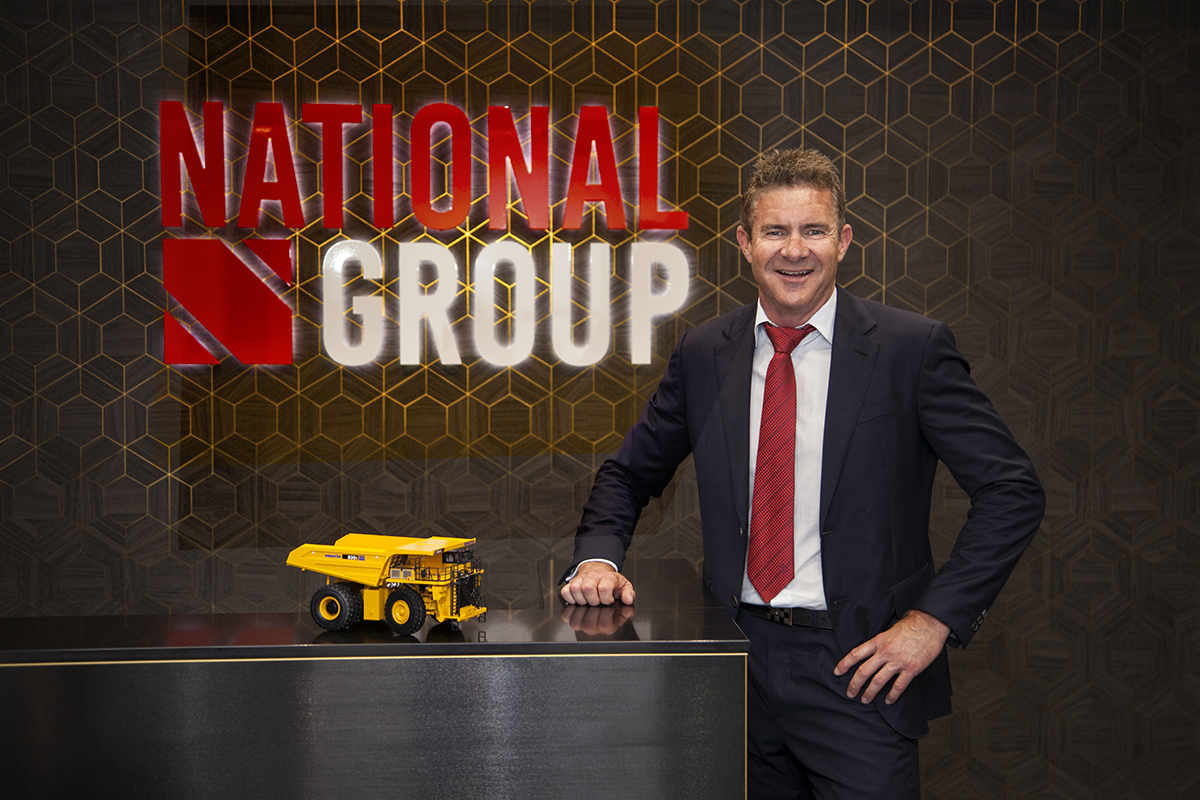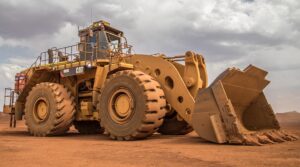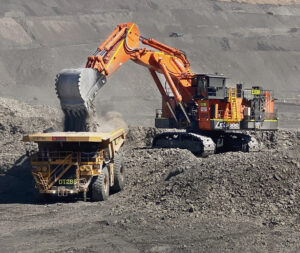Mark Ackroyd weighs in on how COVID-19 has impacted the mining industry
As featured in the June 2020 Edition of Australian Mining Magazine, written by Salomae Haselgrove.

The mining industry will help lead the charge and stimulate the economy as we come out the other end of the coronavirus pandemic
National Group Managing Director Mark Ackroyd has experienced the mining industry’s record-breaking highs and lows during the past two decades. Salomae Haselgrove speaks to Ackroyd about the impact the pandemic will have on the industry.
Since founding National Plant & Equipment, part of the National Group in 1997, Mark Ackroyd has overcome the challenges of the 2008 global financial crisis and the 2015 commodity market downturn, two of the toughest periods in recent history the mining industry in Australia has faced.
In 2020, the industry has been confronted by a new challenge in the form of the coronavirus pandemic, which has seen industries such as the hospitality, travel, tourism and entertainment close their doors.
Only services classified as “essential” by the Australian Government have seen less impact during this crisis. Mining is classified as an “essential service” and has therefore been impacted far less than other industries that help keep the Australian economy strong.
The mining industry although less affected than other industries, has quickly had to adapt to new ways of operating. With State Governments such as Queensland and Western Australia closing their borders, which are home to some of Australia’s key mining operations, this was bound to have an impact on the Australian Mining industry.
Fly-in fly-out (FIFO) employees have had to work under revised rosters in order to reduce inter-state travel and avoid the two-week mandatory quarantine period. Governments at all levels have also imposed strict social distancing measures to help reduce the spread of the virus.
As Ackroyd explains, the coronavirus pandemic has solidified the importance of the mining industry to the Australian economy, as operations and supporting industries help to keep the nation afloat in a time of uncertainty.
“Coronavirus has impacted everyone including businesses and employees, but the mining industry is still very strong,” Ackroyd tells Australian Mining.
According to research by the Grattan Institute, the Australian unemployment rate may rise as high as 10 to 15 per cent due to the impact of the coronavirus, meaning industries such as mining that can not only remain operational, but also create new roles are crucial in keeping the economy healthy.
BHP is an example of this. The company announced in March that it would provide employment opportunities for 1500 workers across its iron ore, coal and copper operations in New South Wales, Queensland, South Australia and Western Australia.
“The mining industry will continue to employ people as the demand for people in the industry has been quite high,” Ackroyd says.
“The coronavirus pandemic is even bringing people back into the industry who have left previously or bringing in new people who are looking for more secure work.”
Despite the threat of the virus, both to businesses and individuals, it is not all bad news for the Australian mining industry.
In mid-late April 2020, oil prices moved into negative territory for the first in history to as low as -$40. The price of oil suffered its biggest single-day drop since the Gulf War in 1991, falling by more than 30 per cent. This was due to the pairing of the Russia and Saudi Arabia oil price war and the coronavirus, resulting in an over supply and a lack of demand.
“Although diesel prices haven’t dropped as much as oil and unleaded fuel, they have come down,” Ackroyd says.
“This makes it cheaper for mining companies to operate equipment, therefore increasing cost efficiency of operating gear on site.”
Around mid-late March 2020, the Australian Dollar dropped to nearly 57 US cents, its lowest value in 17 years. The ASX and international stock markets such as the Dow Jones also dropped as low as 35%, down from recent all-time highs.
Australia is currently an attractive market internationally to purchase commodities and resources from due to the Australian dollar’s low value against its US equivalent, according to Ackroyd.
“A lot of other sectors in Australia have been terribly affected by coronavirus, but mining is still quite positive in this respect,” he says.
“Because the dollar is so low, Australian ore makes for a very attractive purchase for overseas markets such as China and the United States.”
The low prices are not only an advantage from an export point of view, but also for operational costs at mining projects themselves.
With nationwide lockdowns across South American nations including Argentina, Peru and Chile and in African countries such as South Africa and Gambia, the demand for products from Australia could be on the rise.
“Seeing other countries being forced to shut mining down due to lockdowns means importers will turn to other suppliers, such as Australia to find their product,” Ackroyd says.
“Increasing the capacity of Australia’s mines to meet this demand will be positive for the Australian economy and Australian mines, allowing them to continue functioning as normal.”
The demand for the mining industry to continue functioning as normal also has a flow on to other areas, including the original equipment manufacturers such as Caterpillar, Hitachi, Komatsu and Liebherr, which provide the equipment required for mining, as well as the transport and freight industries.
Despite operating as normally as possible, the mining industry is implementing strict safety measures to keep employees, contractors and customers safe.
The National Group for example had to develop responsive measures and contingency plans. Social distancing measures have been implemented, including limiting the number of employees in the office to the minimum level required in order to continue to operate. Most staff are working from home where possible, with regular video conferencing tools being utilised to communicate effectively.
Office based employees are following government directions and staying at least 1.5m apart, and if they are reporting symptoms of feeling unwell they are encouraged to stay at home and self-isolate.
On mine sites, the National Group stagger meal breaks so large groups are not congregating in the same room all at once, splitting pre-start meetings and revising processes where required such as the way equipment is maintained.
With more Australian mines trialling or operating automated or semi-automated equipment, it is another beneficial way in distancing employees while keeping operations going.
“Autonomous mines and remote operations are attractive at the best of times for improving business outcomes and safety, so this could be a game-changer for miners who have embraced autonomy during the worst of times,” Ackroyd says.
“With less human contact and less people required to get the job done, autonomous mines and remote operations are a good way to keep businesses running safely if coronavirus has affected a mine site and staff are required to self-isolate or quarantine.
“Reducing staff during this period to say two people per shift in order to remotely operate autonomous equipment, would allow them to work in a safer environment with less risk of spreading the virus.”
Despite the impact of the virus on the Australian economy, leaders within theresources sector, such as Ackroyd, are positive that the industry will continue to be one of Australia’s most successful.
According to Deloitte’s recent Impacts of COVID-19 on the Mining Sector report, large mining companies will be in better financial shape after coronavirus than they were after the 2008 global financial crisis and 2015 commodity market downturn.
With this in mind, Ackroyd believes the industry is well-positioned to persevere through the difficulties of 2020 and remain strong for years to come.
“I think mining will be one of the few industries that is least affected by thecoronavirus and will help lead the charge coming out the other end of this pandemic,” Ackroyd says.
In mid-late March 2020 during the height of the pandemic in Australia, theAustralian Government pledged a total of $189 billion in order to keep Australians in work and businesses in business. This included $17.6 billion for the Government’s first economic stimulus package, $90 billion from the RBA and $15 billion from the Government to deliver easier access to finance and $66.1 billion in an economic support package.
Between 2015 – 2017, Australia’s mining sector doubled its contribution to funding roads, schools, hospitals, police and other essential services through a massive increase in company tax and royalty payments. Research by Deloitte Access Economics reveals that Australian mining companies paid $18.6 billionin company tax in 2017-18, the highest since the mining investment boom in2011-12. Mining companies also paid $12 billion in royalties in 2017-18, providing total revenue to Commonwealth and State Governments of nearly $31 billion.
“Mining will be one of the key industries that helps to build the economy back up and reduce the deficit. The dollars in taxes that mining contributes to theAustralian Government will help kick-start the economy into a positive position.”
In addition to the economic impact, Ackroyd commended workers for their efforts in keeping businesses running smoothly, despite the effect changes to their work conditions are having on their personal lives, such as longer periods of time away from their families.
“The world wasn’t prepared for this pandemic and there are numerous lessons we will take from it moving forward. The key thing is we need to learn our lessons and take comfort in knowing we have tried and tested contingency plans in place for the future,” Ackroyd concludes.



